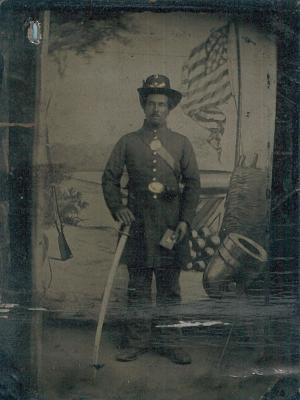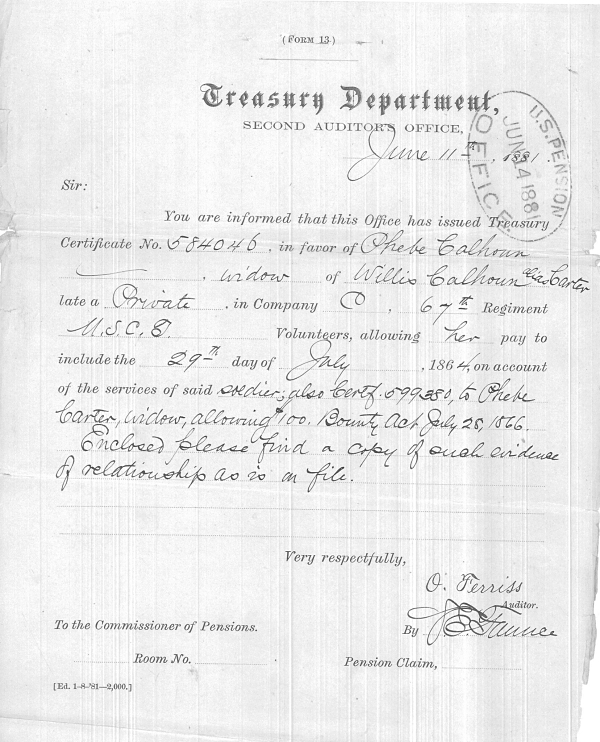
This blog post is one of several that we will publish in 2017 on our Black Virginians in Blue digital project. The project explores the lives of African American men from Albemarle County, Virginia, who served in the USCT. Jonathan White’s piece on James T. S. Taylor was our first blog entry on the subject.
The publication of Civil War soldiers and sailors databases online has been a major boon to genealogists for years. Civil War scholars also can benefit from these digital resources available at subscription and free sites. For example, compiled military service records can be downloaded from Ancestry.com and its subsidiary site, Fold3.com. These records are important for recreating a soldier’s army career and also list important biographical information such as height, age, place of enlistment, birthplace, and rank. In some cases, these records indicate whether or not African American Union soldiers were freemen or slaves when they enlisted. For our forthcoming Black Virginians in Blue digital project, I used digital resources to make substantial progress in researching the lives of black Union soldiers from Albemarle County, Virginia, prior to making a research trip to the National Archives in Washington, DC.
After speaking with historian Ervin Jordan, an expert in local Civil War history, and receiving a few tips from our Associate Director Elizabeth Varon, I started to fill out a spreadsheet in Microsoft Excel of all of the black men from Albemarle County who served in the Union Army or Navy. Dr. Varon found a transcribed descriptive list of all of the African American men who enlisted in U.S. Colored Troop (USCT) regiments in Missouri. Searching through the list yielded thirty-two results for “Albemarle County.” I found seven more for the misspelling “Albermarle” including Private Willis Calhoun who is pictured above. The realization that nineteenth century clerks often misspelled the county’s name proved useful as I continued to track down more men from Albemarle and its county seat, Charlottesville.
Initially, I hoped to rely on other freely available resources as much as possible. While the National Park Service does have a wonderful database of every Civil War soldier who served during the war, this website does not provide the soldier’s birthplace, age, place of enlistment, or other important biographical information. The site’s sailors' database did list such information, however, yielding six more men. In addition to doing a keyword search, I carefully reviewed every single record to make sure I didn’t miss any misspellings.
At this point, I realized that we would need to subscribe to Ancestry.com to access its database of USCT men. The U.S., Colored Troops Military Service Records, 1863-1865 database yielded over fifty men through a search for Albemarle County, VA. I then did a more general search for any man born in the state of Virginia, and I found many misspellings of places in Albemarle County. “Alabama County,” “Albermarle County,” “Sharlottesville,” and “Challetsville,” were some of the misspellings. In all, I found almost fifty more men this way, bringing the total through Ancestry.com to about one hundred. Another of the site’s databases, U.S., Descriptive Lists of Colored Volunteer Army Soldiers, 1864, helped us identify a few more men who enlisted in Kentucky-raised USCT regiments.
While a great resource, the main USCT database on Ancestry.com only contained records from the first fifty-five USCT infantry regiments, plus all of the Union’s black artillery and cavalry units. In the first week of August, I spent four days at the National Archives looking through the available USCT descriptive books for regiments 56 through 138. These books, generally recorded twice for individuals companies as well as the larger regiment, list important biographical data about Union army soldiers at the time of enlistment. I added seventy-four more names to our database.
 Unfortunately, dozens of these descriptive books for USCT infantry regiments 56 though 138 are either incomplete or missing at the National Archives. The only way to search for more Albemarle men at this point was to examine individual compiled military service records in the hopes that a descriptive book card had been filled out for the soldier prior to the disappearance of his company’s or regiment’s descriptive book. We are currently examining about thirty USCT infantry regiments by paging through digitized individual compiled service records located on Fold3.com. The process is tedious but much faster than ordering and examining these records at the National Archives.
Unfortunately, dozens of these descriptive books for USCT infantry regiments 56 though 138 are either incomplete or missing at the National Archives. The only way to search for more Albemarle men at this point was to examine individual compiled military service records in the hopes that a descriptive book card had been filled out for the soldier prior to the disappearance of his company’s or regiment’s descriptive book. We are currently examining about thirty USCT infantry regiments by paging through digitized individual compiled service records located on Fold3.com. The process is tedious but much faster than ordering and examining these records at the National Archives.
With the assistance of two University of Virginia undergraduates, we will finish this last phase of our search for USCT men in the Spring 2017 semester. I expect that we will have between 250 and 300 Albemarle black soldiers and sailors in our database once our search is complete. We will then search through two different pension file indexes (on Ancestry.com and Fold3.com respectively) to find pension records for as many of our men as possible. These records contain extremely rich information about soldiers’ post-war lives, their health and employment issues, as well as information about their wives, children, and other family members.
Once we have a complete list of all men from Albemarle who served in the Union military, we will begin to enter data from their compiled military service records and pension files into a relational database. This database was designed and is hosted by the Institute for Advanced Technology in the Humanities (IATH) at UVA. The database will function as the core of our project’s website that we hope to publish online in 2017 or 2018. We hope that Black Virginians in Blue will prove to be an excellent resource for historians, genealogists, and the public, allowing anyone to search freely and learn more about this important, but sorely neglected, part of Albemarle County’s Civil War story.
William B. Kurtz is the digital historian and archivist at the Nau Center for Civil War History.
Sources: Compiled Service Records, RG 94 National Archives and Records Administration, Washington, D.C. (hereafter NARA), accessed for each Black soldier through Fold3 (https://www.fold3.com/browse/273/); USCT Regimental Descriptive Books, RG 94, NARA; Pension Records for Civil War Soldiers, RG 15, NARA; “Search for Sailors,” Civil War Soldiers and Sailors System database, National Park Service (https://www.nps.gov/civilwar/search-sailors.htm); “U.S., Colored Troops Military Service Records, 1863-1865,” Ancestry.com (https://www.ancestry.com/search/collections/1107/); “U.S., Descriptive Lists of Colored Volunteer Army Soldiers, 1864,” Ancestry.com (https://www.ancestry.com/search/collections/2132/); "Descriptive Recruitment Lists of Volunteers for the United States Colored Troops for the State of Missouri, 1863-1865," St. Louis County Library (https://www.slcl.org/content/descriptive-recruitment-lists-volunteers-united-states-colored-troops-state-missouri-1863-18).
